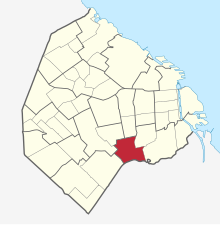Nueva Pompeya
Nueva Pompeya is a district in the southeast of the Argentine capital Buenos Aires . It has 63,276 inhabitants (as of 2001) on an area of 6.1 km² , which corresponds to a population density of 10,373 inhabitants per km². Between 1991 and 2001 the population increased by over 18 percent.
history
Nueva Pompeya got its name after the "Virgen del Rosario de Pompeya", who is venerated there in a church.
The district was mostly laid out on an alluvial plain on the north bank of the Riachuelo and was often affected by flooding. The area was therefore only sparsely populated and also notorious for poverty and a high crime rate.
Until 1930, when industrial companies also settled there, most of the residents of Nueva Pompeya worked in the slaughterhouse in the neighboring Parque Patricios . Avenida Sáenz, one of the main streets of Nueva Pompeya, is still known today as the “Street of Bones” because cattle often died on the way to the slaughterhouse.
The area was also known for its pulperías , bars used by gauchos and slaughterhouse workers. Two of them have been converted into museums: La Blanqueada and Pulpería de María Adelia .
Cityscape
In the course of the 20th century, Nueva Pompeya got its current appearance. In 1938 the José Felix Uriburu Bridge, mostly known as the " Puente Alsina " (Alsina Bridge), was inaugurated. The residential streets of the quarter consist mainly of single-storey terraced houses.
One of the largest Villas Miserias in Buenos Aires also belongs to the district . It was created by the influx from poorer rural areas in northern Argentina and by immigrants from Bolivia. Most of the residents work as unskilled workers and seamstresses.
There are a number of public facilities in Nueva Pompeya. In 1940 the "Círculo Católico Obrero" opened in Avenida Sáenz 1342 and there has been an indoor swimming pool since 1965. One of the founders of the Catholic circle, Carlos Valdisseri, also founded the “Complejo Social y Cultural de Nueva Pompeya”, which until recently was headed by his son, Father Jorge Valdisseri. Since the economic crisis of 2000, z. B. Set up soup kitchens to help the needy in the district.
The economy of the quarter was supported by metal and meat processing companies until 1980. Many of them closed for economic policy reasons. The buildings that are no longer needed are now used as warehouses and “ factory outlets ”.
Next to the Doctor Antonio Sáenz train station, at the Av. Sáenz and Av. Moreno has a bird market every Sunday. It is known for its range of songbirds.
Nueva Pompeya: cradle of tango
The arrival of European immigrants since 1880 brought a revival to Buenos Aires. Most of them settled in the south of the city, where many of their descendants still live today. Besides Nueva Pompeya, preferred residential areas were La Boca and Barracas , where they lived in simple, often self-built houses. When they started their new life in South America, they developed a typical culture that was rooted in their European origins. The Tango Argentino was born in this climate . One of the first places where tango was danced in Buenos Aires was a dance hall at the intersection of Corrales Street and Avenida La Plata. Other tango halls opened here later, e.g. B. the “Bar del Chino” on Beazley Street, and musicians like Homero Manzi wrote and performed tangos here. Nueva Pompeya is also mentioned in the well-known tangos "Barrio de Tango" and "Sur". At the intersection of Tabaré and Del Barco Centenera you will find a mural reminiscent of Manzi.
Iglesia del Rosario de Nueva Pompeya
It is said that Bartolo Longo noticed a portrait in Pompeii , Italy that was supposed to be cremated because of its poor condition. Without knowing who was depicted in the painting, he fell in love with the portrait. The portrait showed the Virgin of Rosario accompanied by Saints Santo Domingo and Santa Catalina de Siena .
He became an ardent follower and began to spread the veneration of the Virgin of Rosario. Years later, when he emigrated to Argentina, he preached there on the virtues of the virgin. The then emerging district was then named after her, two streets in Nueva Pompeya were given the names of the saints accompanying the Virgin.
On May 14, 1896, the foundation stone for a chapel was laid. The construction was under the direction of the architect and painter Augusto César Ferrari and was blessed on June 29, 1900. It has been its own parish since 1905.
The church was built in the neo-Gothic style, which subsequently became popular in other parts of Buenos Aires. It has a tower and the nave is decorated with windows depicting the 15 Mysteries of Santo Rosario. The richly decorated main portal is made of wrought iron. Parts of the church were made from rubble stones found in Pompeii. In the 1920s it was expanded to continue to accommodate the growing parish. Inside, the church is adorned with oil paintings of commercial sailors and historical events. Numerous statues adorn the main nave. In the patio of the church there is a bronze monument in honor of the Virgin of Rosario.
Web links
Individual evidence
Coordinates: 34 ° 39 ′ S , 58 ° 25 ′ W



